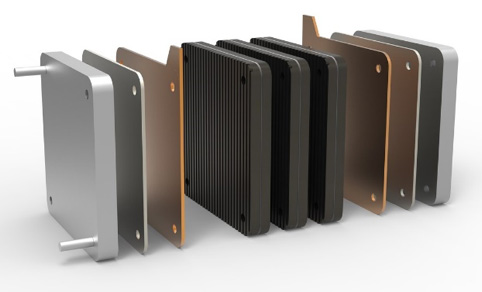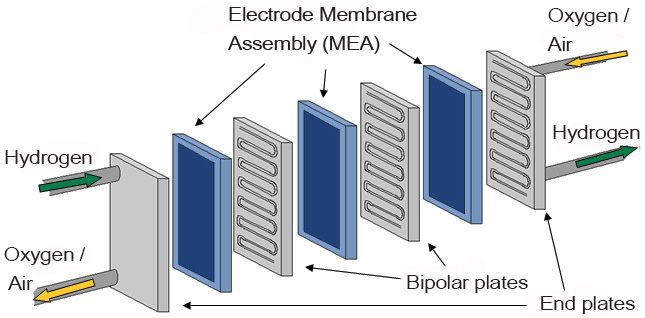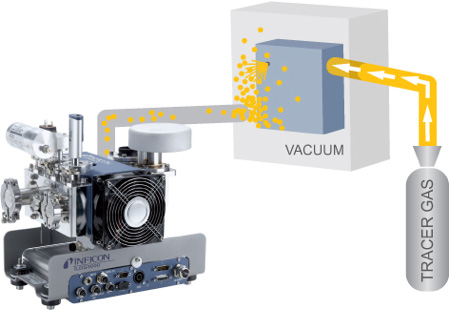Leak Testing of Fuel Cell Bipolar Plates
Description of Technical Challenge


Fuel stacks are assembled from MEAs, bipolar plates and two end plates. The hydrogen path is only created after two bipolar plates and an MEA have been joined.
Fuel cell stacks consist of two endplates and several bipolar plates separated by membrane electrode assemblies (MEAs). Essentially, the bipolar plates are the electrically-conducting plates which join together the anode of one cell to the cathode of another. Bipolar plates contain two cavities and one internal loop:
- Two cavities for the fuel cell process gases – hydrogen and air / oxygen
- one internal loop for cooling liquid to maintain an optimum process temperature of the stack
Both cavities and the internal loop need to be tested for leakage.
- The hydrogen path must not leak hydrogen to the outside as hydrogen gas is flammable.
- The cooling path must not leak cooling liquid to the outside not to cause any electric shortage but also not to lose cooling capacity.
- Last but not least, hydrogen must not leak into the cooling channel as this would cause corrosion of material and also can create problems with the pump in the cooling channel due to gas bubbles in the liquid.
Different leak rate requirements apply for the different scenarios:
The leakage of hydrogen to the outside as well as into the cooling channel should typically be limited to leak rates in the range of 10-4 ... 10-6 mbar l/s to limit the amount of hydrogen being released. The leakage of cooling liquid from the cooling channel should be limited to leak rates in the range of 10-4 .. 10-5 mbar l/s as leaks of this size will block with the cooling liquid and not allow any further cooling liquid to leak out.
The INFICON Solution

Fuel cell bipolar plates are typically tested in a vacuum chamber leak test due to low leak rate requirements and need for high throughput.
Testing for leakage of cooling liquid
To test the coolant loop of a bipolar plate, the coolant loop is evacuated from air and backfilled with helium before the coolant loop is sealed off. The bipolar plate is then placed in a vacuum chamber. After the vacuum chamber has been evacuated, an LDS3000 leak detector is connected to the vacuum chamber and any helium leaking from the coolant loop is detected. After the chamber has been vented, helium may be reclaimed from the cooling loop.
Testing for hydrogen leakage to the outside
Before testing for hydrogen leakage to the outside, the hydrogen cavity needs to be closed and sealed off. The resulting volume is then evacuated and backfilled with helium before the inlet port is closed and the bipolar plate is placed in a vacuum chamber. The vacuum chamber is evacuated and an LDS3000 leak detector is connected to the chamber. Any helium leaking from the hydrogen cavity is detected by the leak detector. If a leak was detected, in a second test it can be determined if the leak is to the outside or into the cooling channel.
If no helium is detected, no relevant leaks from the hydrogen cavity to the outside nor into the cooling channel exist. The chamber is then vented and the helium may be reclaimed from the hydrogen cavity.
Testing for hydrogen leakage into the cooling channel
With the hydrogen cavity still charged with helium and sealed off, now the cooling channel is connected to a vacuum pump and evacuated to vacuum pressure. The LDS3000 leak detector is now connected to the cooling channel and any helium leaking from the hydrogen cavity into the cooling loop is detected by the leak detector. The cooling loop is vented after the test and helium may be reclaimed from the hydrogen cavity.
If no leak is detected, the leak found in the previous test is a hydrogen leak to the outside.
Benefits of Leak Testing With Tracer Gas
- High reliability of leak detection
- Repeatable and reproducible process
- Results traceable to national standards
- No influence of temperature or humidity
- Identification of leak source
For more information on leak testing fuel cells, please visit us at www.inficonautomotive.com or call your nearest sales representative.
